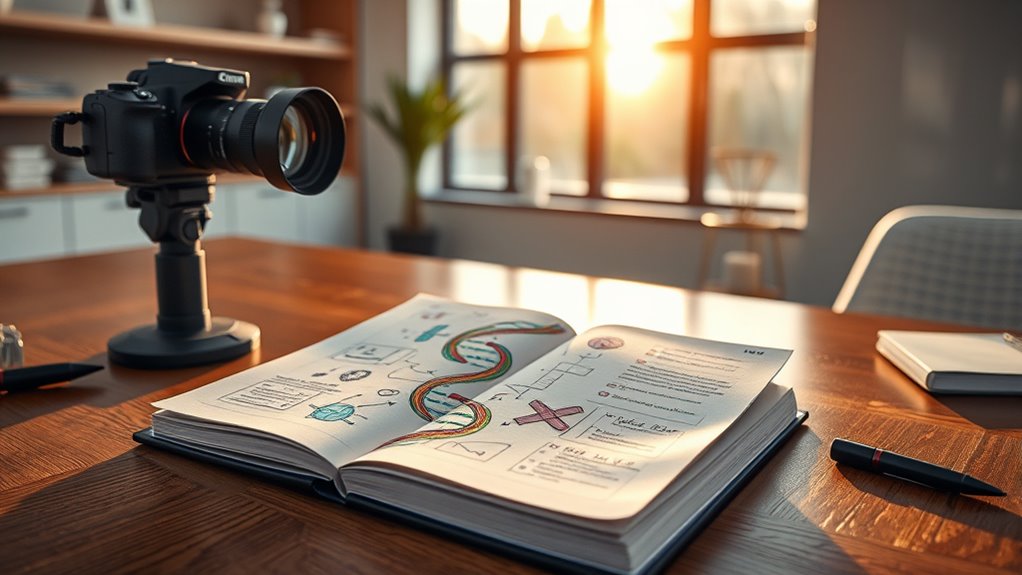To decode your decision-making DNA, start by recognizing how emotional biases and mental shortcuts influence your choices. Pay attention to gut reactions, instincts, and easy-to-recall examples which often sway your judgment unconsciously. Use simple tools like checklists and reflection pauses to challenge automatic responses and question whether your decisions are truly deliberate. Becoming aware of these hidden influences helps you make clearer, more objective choices—exploring the framework further reveals how to master your decision-making process.
Key Takeaways
- Identify emotional biases like attachment or overconfidence that influence your choices.
- Recognize cognitive shortcuts such as heuristics and confirmation bias impacting decision clarity.
- Observe your gut reactions and automatic responses to uncover underlying biases.
- Use a structured mental checklist to evaluate whether emotions or shortcuts are guiding your decisions.
- Develop self-awareness to challenge biases, enabling more deliberate and objective decision-making.

Have you ever wondered what truly drives effective decision-making? Understanding your decision-making DNA starts with recognizing the subtle influences that shape your choices every day. One of the most common factors are emotional biases—those automatic, often unconscious feelings that sway your judgments. These biases act like emotional filters, coloring your perception of risk, reward, and relevance. For instance, you might instinctively cling to familiar options because of an emotional attachment, or you might overvalue recent successes while downplaying potential pitfalls. These biases are deeply rooted in your mind’s wiring, developed through past experiences and personal values, and they can cloud your objectivity if you’re not aware of them.
Alongside emotional biases, cognitive shortcuts—also known as heuristics—play a significant role in decision-making. Your brain is wired to simplify complex information by relying on these mental shortcuts to save time and mental energy. They help you make quick decisions in everyday situations but can also lead to errors or skewed judgments. For example, you might rely on the availability heuristic, judging the likelihood of an event based on how easily examples come to mind, which can distort your perception of actual risks. Or, you might fall into the confirmation bias trap, favoring information that supports your existing beliefs rather than objectively evaluating all evidence. Recognizing these shortcuts is vital because they often operate beneath your awareness, subtly guiding your choices without your conscious realization. Interestingly, understanding how contrast ratio influences image quality can help you better evaluate visual information, just as recognizing cognitive biases enhances your decision-making.
To decode your decision-making DNA, you need to identify which emotional biases and cognitive shortcuts influence you most. Start by paying close attention to your gut reactions—those quick judgments that feel instinctive. Ask yourself whether your emotions are clouding your reasoning or if you’re relying on mental shortcuts that might oversimplify the situation. Developing this awareness allows you to step back and challenge automatic responses, giving you space to make more deliberate choices. It’s about creating a mental checklist that questions your initial impressions and emotional reactions, ensuring you’re not just acting on impulse or subconscious bias.
Frequently Asked Questions
How Can I Identify My Unique Decision-Making Style?
To identify your unique decision-making style, start by observing your decision patterns in different situations. Pay attention to how you gather information, weigh options, and respond under pressure. Recognize your cognitive styles—whether you’re analytical, intuitive, or decisive—and notice which approach feels most natural. Reflect on past choices to see consistent tendencies. This self-awareness helps you understand your decision-making preferences and improve your overall process.
Does This Framework Work for All Types of Decisions?
You wonder if this framework applies to all decisions. While it’s helpful in revealing your decision biases and improving cognitive flexibility, it may not suit every situation perfectly. Complex or high-stakes choices might require additional tools or methods. However, by understanding your biases and adapting your thinking, this framework can guide you through many types of decisions, making your process more intentional and aware.
Can I Change My Decision-Making DNA Over Time?
You might think your decision-making DNA is fixed, like genetic predispositions carved in stone, but environmental influences show otherwise. Just as your environment shapes your habits, you can change how you make decisions over time. While some patterns are ingrained, your experiences and choices can reprogram your approach, allowing you to evolve. So yes, with awareness and effort, you can transform your decision-making DNA, becoming more adaptable and conscious.
How Does Emotions Influence My Decision-Making DNA?
Emotions greatly influence your decision-making DNA by shaping your emotional biases and gut instincts. When you feel strongly about something, your emotions can override logical analysis, pushing you toward certain choices. These emotional biases act as internal filters, affecting how you interpret information. Your gut instincts, often rooted in emotions, can guide you quickly but may also lead to impulsive decisions. Recognizing this helps you better understand and manage your decision-making process.
Are There Tools to Measure My Decision-Making Profile?
You can find tools that measure your decision-making profile by evaluating your cognitive styles and decision-making biases. These assessments often include questionnaires or quizzes that identify patterns in how you approach choices, highlighting tendencies like impulsivity or analysis paralysis. By understanding your profile, you gain insights into your strengths and blind spots, empowering you to make more mindful decisions and improve your overall decision-making process.
Conclusion
By understanding your Decision-Making DNA, you gain clarity on how you approach choices—making each decision more intentional. Interestingly, studies show that 70% of successful leaders attribute their effectiveness to self-awareness of their decision styles. When you decode your decision-making framework, you not only enhance your confidence but also improve outcomes. Embrace this simple tool to access smarter, more aligned choices every time, turning your decision-making process into a powerful asset.
Felicity, our Author, pens in-depth articles and guides that delve into the heart of personal discovery. Her narrative-driven approach weaves together theory, practice, and personal anecdotes, making the journey of self-exploration both relatable and inspiring. Felicity’s contributions help illuminate the path for those seeking a deeper understanding of themselves and their relationships.










